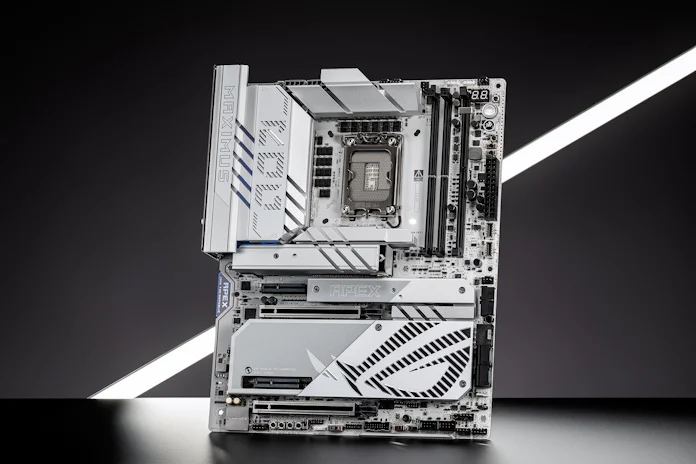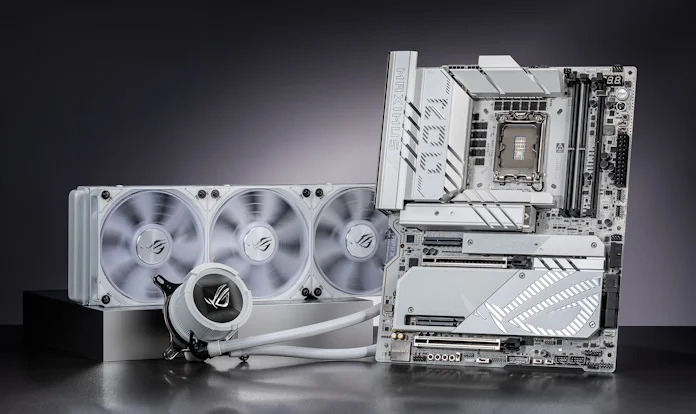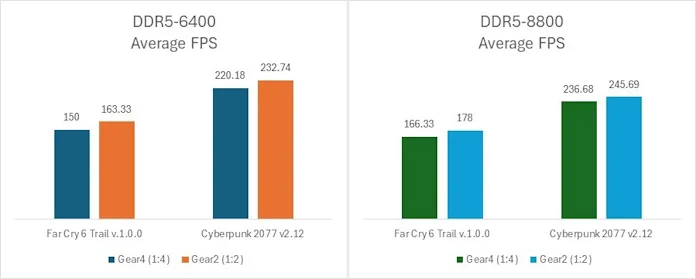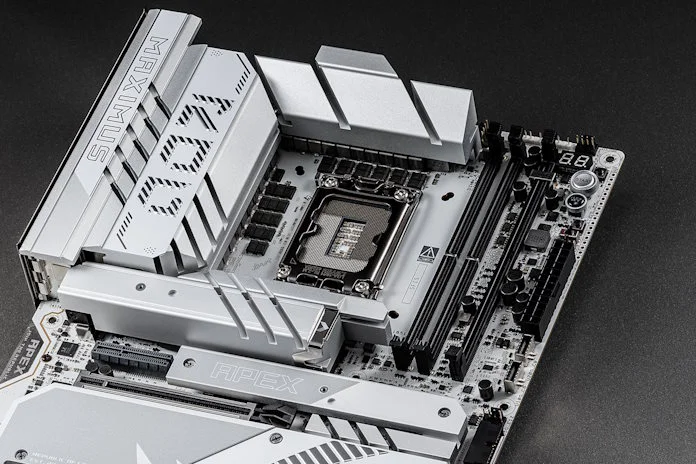Five world records, nineteen global first place records, and 31 first place records: that’s the haul of overclocking trophies brought home by the ROG Maximus Z890 Apex. In the hands of some of the world’s premiere professional overclockers, this motherboard was able to coax dazzling performance out of Intel’s latest Core Ultra (Series 2) lineup and the latest high-performance memory kits.
Veterans of the overclocking scene won’t be surprised to learn that these records were achieved with an Apex board on the bench. This motherboard series has undeniable pedigree. Since the very first model, we’ve designed Apex motherboards for the singular purpose of helping the world’s most talented overclockers shatter barriers on their way to new records.

The ROG Maximus Z890 Apex takes the series to new heights with a beefy 22+1+2+2 power solution ready to take Arrow Lake to the stratosphere. But the true strength of the Apex is in its memory layout. In order to reduce interference to the IMC, the Apex runs two DIMM slots instead of four, sacrificing raw capacity so that it can attain record-breaking frequencies.
Show me the numbers
The innovative layout of the ROG Maximus Z890 Apex is proving itself on the overclocking battlefield. Today, we’re proud to announce the records achieved by veteran overlockers with this board in hand.
The memory frequency achieved by overclocker Bing Lin deserves special recognition. Using the ROG Maximus Z890 Apex, Bing Lin was able to push a memory kit all the way up to 12,112MT/s for a new world record.
Famed overclocker Elmor took an Intel Core Ultra 9 285K to dizzying heights with the ROG Maximus Z890 Apex. Using an innovative overclocking setup, Elmor pushed this CPU to 7488.8MHz. The overclocking was conducted with liquid helium using the AI LN2 pot, a project by 3D Systems, Diabatix, ElmorLabs, and SkatterBencher. This LN2 pot was designed with generative AI technology from Diabatix that allowed the team to rapidly explore a stunning range of design alternatives. The output of the generative AI process was unlike anything else on the market and required the cutting-edge 3D printing tech of 3D Systems to bring to life, but the results speak for themselves.

As impressive as these results are, they’re only a small selection of the overclocking records achieved with the ROG Maximus Z890 Apex and Intel Core Ultra (Series 2) CPUs. Take a look:
| Intel Core Ultra 9 285K | ||
|---|---|---|
| Benchmark | Record | Overclocker |
| CPU-Z Frequency (LHE) | 7488.8MHz (First Place) | Elmor |
| Memory Frequency | 12112MT (World Record) | Bing Lin |
| 3DMARK CPU Profile 1T | 1793 (World Record) | Elmor |
| 3DMARK CPU Profile 2T | 3560 (World Record) | Elmor |
| 3DMARK CPU Profile 4T | 7044 (World Record) | Elmor |
| 3DMARK CPU Profile 8T | 13242 (World Record) | Elmor |
| Y-CRUNCHER Pi 1B | 11.446 s (First Place) | OGS |
| Cinebench R11.5 | 111.98 pts (First Place) | BenchMarc |
| Cinebench R15 | 9355 cb (First Place) | BenchMarc |
| Cinebench R20 | 23692 pts (First Place) | OGS |
| Cinebench R23 | 60840 pts (First Place) | BenchMarc |
| Geekbench 3 Multi | 179845 (First Place) | CENS |
| Geekbench 3 Single | 12204 (First Place) | BenchMarc |
| Geekbench 4 Multi | 136028 (Global First Place) | OGS |
| Geekbench 5 Multi | 38267 (First Place) | OGS |
| GPUPI for CPU - 1B | 25s 523ms (First Place) | OGS |
| 7-Zip | 271180 MIPS (First Place) | OGS |
| HWBOT x265 Benchmark 1080p | 290.985 fps (First Place) | OGS |
| HWBOT x265 Benchmark 4k | 70.224 (First Place) | OGS |
| XTU 2.0 | 22465 (Global First Place) | OGS |
| Intel Core Ultra 7 255K | ||
|---|---|---|
| Benchmark | Record | Overclocker |
| Y-CRUNCHER Pi 1B | 12.718 s (First Place) | OGS |
| Cinebench R11.5 | 93.72 pts (Global First Place) | OGS |
| Cinebench R15 | 7731 cb (Global First Place) | OGS |
| Cinebench R20 | 20045 pts (Global First Place) | BenchMarc |
| Cinebench R23 | 51360 pts (Global First Place) | BenchMarc |
| Geekbench 3 Multi | 151185 (Global First Place) | OGS |
| Geekbench 3 Single | 11529 (First Place) | BenchMarc |
| Geekbench 4 Multi | 119833 (First Place) | OGS |
| Geekbench 4 Single | 12109 (First Place) | BenchMarc |
| Geekbench 5 Multi | 34087 (First Place) | OGS |
| Geekbench 5 Single | 2983 (First Place) | BenchMarc |
| Geekbench 6 Multi | 27088 (First Place) | BenchMarc |
| Geekbench 6 Single | 4068 (First Place) | BenchMarc |
| GPUPI for CPU – 100M | 2s 07ms (First Place) | BenchMarc |
| GPUPI for CPU - 1B | 30s 529ms (First Place) | OGS |
| GPUPI for CPU 3.3 – 100M | 1s 816ms (First Place) | BenchMarc |
| GPUPI for CPU 3.3 - 1B | 30s 393ms (First Place) | BenchMarc |
| wPrime - 1024m | 30s 555ms (First Place) | BenchMarc |
| 7-Zip | 231088 MIPS (First Place) | OGS |
| HWBOT x265 Benchmark 1080p | 251.787 fps (Global First Place) | OGS |
| HWBOT x265 Benchmark 4k | 60.506 fps (Global First Place) | OGS |
| XTU 2.0 | 18811 (Global First Place) | OGS |
| Intel Core Ultra 5 245K | ||
|---|---|---|
| Benchmark | Record | Overclocker |
| Y-CRUNCHER Pi 1B | 16.957 s (First Place) | OGS |
| Cinebench R11.5 | 66.91 pts (Global First Place) | OGS |
| Cinebench R15 | 5523 cb (First Place) | OGS |
| Cinebench R20 | 14249 pts (First Place) | OGS |
| Cinebench R23 | 36695 pts (First Place) | OGS |
| Geekbench 3 Multi | 108408 (Global First Place) | OGS |
| Geekbench 4 Multi | 94502 (Global First Place) | OGS |
| Geekbench 5 Multi | 26518 (Global First Place) | OGS |
| 7-Zip | 170571 MIPS (First Place) | OGS |
| HWBOT x265 Benchmark 1080p | 184.438 fps (Global First Place) | OGS |
| HWBOT x265 Benchmark 4k | 44.829 fps (Global First Place) | OGS |
| GPUPI for CPU – 1B | 43s 27ms (First Place) | OGS |
| XTU 2.0 | 13765 (Global First Place) | OGS |
Congratulations to Elmor, BenchMarc, OGS, and CENS for these impressive results.
When two is greater than four
While most users won’t be clamping a liquid nitrogen pot to their new Intel Core Ultra (Series 2) CPU, there are some lessons that PC enthusiasts can learn from these professional overclockers when it comes to extracting the most performance out of their new system.
One important insight concerns memory gear modes. If you haven’t worked with memory gears before, here’s a brief primer. In the past, a processor’s memory controller would operate at a frequency equal to memory speed. We call this 1:1 ratio “Gear 1.” But as DDR4 modules were developed with increasingly higher frequencies, a new approach was needed to enable the higher memory module data rates. Accordingly, Gear 2 was introduced, a mode in which the processor memory controller operates at half the memory speed. This approach enhances compatibility and provides greater potential for pushing data rates to higher levels.
Today’s DDR5 memory kits are so fast that Gear 1 is no longer an option. With the latest Intel Core Ultra (Series 2) processors, you have the choice between Gear 2 and Gear 4. Gear 4 operates the CPU memory controller at a quarter of the memory clock speed, and it’s the default setting for most Z890 motherboards due to its excellent compatibility.
However, Gear 4 comes with a tradeoff in the form of higher memory latency. In this regard, Gear 2 is demonstrably better, and that’s especially true in the 6400-8000MHz frequency range. For example, we observed 18.8% lower latency with the Intel Core Ultra 9 285K and DDR5-8000 when we switched from Gear 4 to Gear 2, as measured with AIDA64.
Switching to Gear 2 instead of Gear 4 can even allow a memory kit to perform above its specifications. At DDR5-9000 with Gear 2, an extremely fast CUDIMM kit with the Intel Core Ultra 9 processor 285K recorded faster memory read speeds and 12.48% lower latency than when it was configured for DDR5-9600 and Gear 4.

The latency difference between Gear 2 and Gear 4 isn’t just visible in synthetic benchmarks — you’ll notice it in games, too. We compared the performance of two memory kits in Gear 2 and Gear 4 in Far Cry 6 and Cyberpunk 2077 at Full HD, and saw up to 8.8% higher FPS at Gear 2.
Accordingly, we’ve selected Gear 2 as the default setting for ASUS Z890 motherboards. This means that you won’t have to fuss with your memory settings to enjoy the advantages of Gear 2.
Fully equipped for premium memory performance
Exciting advancements in the world of DDR5, like new Clock Unbuffered DIMM (CUDIMM) memory modules, have created no small amount of speculation among enthusiasts. Impressive memory performance is becoming possible, even for folks who aren’t resorting to exotic cooling methods. With the ROG Maximus Z890 Apex, for example, we were able to achieve DDR5-10266 at a CAS latency of 46.

Yet you’re not limited to this one motherboard if you’re in the market for next-level memory performance. The ROG Maximus Z890 Extreme, ROG Maximus Z890 Hero, and ROG Strix Z890-E Gaming WiFi all feature NitroPath DRAM Technology. This cutting-edge redesign of the venerable DRAM slot improves signal quality, increasing DRAM overclocking performance by up to 400 MT/s depending on factors like memory speed, module, and system configuration. With these boards, you can enjoy premium memory speeds along with the capacity upgrade options available with their four DIMM slots.
We’ve also put in the extra legwork to make sure that you have an easy time optimizing the latest CUDIMM memory kits. ASUS Z890 motherboards include ASUS Enhanced Memory Profile III (AEMP III). This advanced firmware feature empowers you to achieve unparalleled memory performance with cutting-edge CUDIMM memory. Through a two-phase comprehensive tuning process, AEMP III first optimizes the clock driver and then the memory frequency. This results in the best balance between performance and stability, even at cutting-edge speeds of DDR5-8000 or higher.*
Not just for professional overclockers
ASUS Z890 motherboards offer a wealth of advantages above and beyond robust support for CPU and memory overclocking. With a wide range of options across our ROG, TUF Gaming, ProArt, and Prime motherboard families, you’re sure to find an option that fits your style, performance needs, and budget. Click here for an overview of our full Z890 motherboard family.

*Results may vary according to individual system specifications, including memory kit and motherboard model. Currently, only 2-DIMM configurations are supported. Results are based on a test with an Intel Core Ultra 9 285K processor and 2x16GB SK Hynix DDR5-6400 Clocked Unbuffered DIMM RAM, model HMCG78AHBCA326N.

